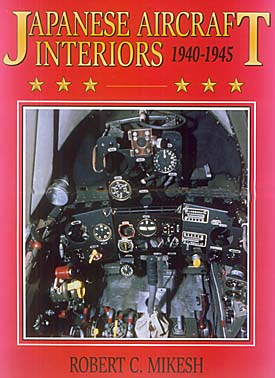 Japanese Aircraft Interiors 1940-1945 Japanese Aircraft Interiors 1940-1945
Robert C. Mikesh
Monogram Aviation Publications, ©2000
ISBN 0-914144-61-8
Hardbound, 328 Pages Reviewed by Paul Ludwig Japanese Aircraft Interiors 1940 - 1945" written by Robert Mikesh and published by Monogram arrived in my mailbox as a total surprise. I can not remember when I ordered it or what I paid for it, it was so long ago. But I am glad I got it. You will be too, if you buy it. I once met Bob Mikesh and mispronounced his name and he told me it is pronounced mick-ish. That said, I am astounded by his and Monogram's "Japanese Aircraft Interiors." Bob Mikesh has contributed mightily to the preservation and restoration of rare aircraft at the NASM and his books have been an asset to us modelers. I had not bought Kenneth Merrick's "German Aircraft Interiors 1935 - 1945" also published by Monogram, so I borrowed it from Ted Holowchuk, to make the comparison with which to write this review. The two books are similar, but it is apparent that the photographic resources and the presentations of the material in the two books is different, and no doubt Bob Mikesh was able to call upon resources in a somewhat greater manner than Ken Merrick. I would also say that Bob Mikesh appreciates modelers, by the way his book appears. The first two notable differences in Mikesh's book are: (1) the excellent cutaway drawings done by Giusppe Picarella, and (2) the effort to have Thomas Tullis do all the face-on instrument panel drawings. A third difference is the standardization factor in Mikesh's book. In Merrick's fine book, there is a variety of cockpit drawings which may have been done by different artists. The differences range from less distinct drawings to those easier understood. There is a full-cockpit drawing of the FW 190 A-8 on page 147 done by one artist, and the full-cockpit drawing of the Bf 109 E-3 on page 62 done by someone else. Both types are seen by the viewer as if he is sitting far back in the cockpit and the near objects have the necessary foreshortened depiction giving them much greater size in comparison to the more distant instrument panel. Mikesh made an effort to depict a standardized presentation of cockpits for each plane through photos, of course, but mainly through the efforts of two artists. Picarella's cutaway drawings and Tullis' flat-panel drawings afford a more realistic treatment of sizes and placements of the equipment in Japanese cockpits. This is not a criticism of Merrick's book. Most modelers should find Merrick's book just as valuable as Mikesh's despite the differences. However, I do prefer the Picarella cutaways, should I make a model with a full cockpit. As in Merrick's, Mikesh unearthed details of Japanese aircraft most of us have never seen and for that reason alone, the new book is a wealth of information about interiors. As a former pilot I am fascinated by close-up color photos of individual instruments. I'm not altogether sure why I am, since an instrument in a scale model often appears too small to the naked eye, but beside that point, looking into a former enemy's cockpit is a bit like window-peeping: there is a thrill in being privy to former secrets. World War Two cockpits are a lot like the boiler room on a ship: foreign, cramped and confusing and not user-friendly, as they say nowadays. That said, to see the cockpit of the Myrt is a thrill. Whatever was its performance, the Myrt was a beautiful design. If length of fuselage and spread of landing gear are any criteria of beauty, the Myrt is in a class all by itself. Naturally the family of Zeroes has to be presented, and the A6M2, A6M3, A6M5 and A6M7 are each given wonderfully detailed exposure. Where the NASM has fully restored a Japanese aircraft, Mikesh and his crew went to great lengths to portray the subject totally. The Irving looks fresh off the assembly line and Mikesh devoted fifteen pages of color photos and drawings to it. I have not had a chance to read Mikesh's book but it is obvious at a glance - besides the color chip presentations - that questions about the interior colors of Japanese aircraft are laid to rest, thanks to Bob Mikesh and Tom Hitchcock of Monogram. Lastly, some examples of Japanese aircraft were not preserved at the end of the war, and all that can be depicted of those lost to us are wartime black-and-white intelligence photos of cockpits taken under poor lighting conditions in the field of a former battle. And G.I. thieves ransacked the cockpits for souvenirs of some of the Japanese aircraft before the planes were guarded and then preserved, leaving questions about those cockpits that modelers must solve themselves. But "Japanese Aircraft Interiors" is the finest there shall ever be, of that subject, and whatever the price of the book, if you are interested, buy it. It has 328 pages to the German book's 256. Monogram called its German book "Volume 1" but there may be a long wait for Volume 2. | 


 



  
    |
 Japanese Aircraft Interiors 1940-1945
Japanese Aircraft Interiors 1940-1945






